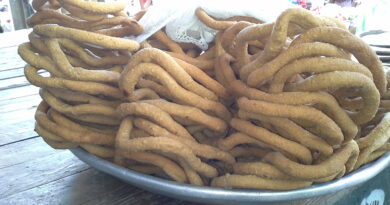Samosa
Crispy Triangles of Delight: Unveiling the Enigmatic Journey of Samosa
In the realm of global street food, few snacks hold as much universal appeal as the beloved samosa. These crispy, golden triangles, filled with a savory mixture of spiced potatoes, peas, and sometimes meat, have captured the hearts and taste buds of people around the world. From bustling markets in India to trendy food trucks in New York City, the samosa’s irresistible combination of flavors and textures has made it a cherished culinary icon. Join me as we embark on a gastronomic journey to uncover the rich history, diverse variations, and enduring popularity of the humble samosa.
A Brief History of the Samosa
The origins of the samosa can be traced back centuries to the kitchens of the Middle East and Central Asia. It is believed that the precursor to the modern samosa was introduced to the Indian subcontinent by traders and travelers from Persia (modern-day Iran) during the medieval period. Over time, the recipe evolved, incorporating local ingredients and culinary traditions to create the iconic snack we know today.
The word “samosa” itself is thought to have originated from the Persian word “sanbosag,” which refers to a type of stuffed pastry. From its humble beginnings, the samosa quickly gained popularity throughout the Indian subcontinent and beyond, becoming a staple street food and party snack enjoyed by people of all backgrounds.
Ingredients and Preparation
While the exact recipe for samosas can vary depending on regional preferences and cultural influences, the basic components remain consistent. The classic filling typically consists of diced potatoes, peas, onions, and a blend of aromatic spices such as cumin, coriander, turmeric, and garam masala. Some variations may also include minced meat, such as lamb, chicken, or beef, adding an extra layer of richness and flavor.
The filling is encased in a thin layer of dough made from flour, water, and sometimes a touch of oil or ghee (clarified butter). The dough is rolled out into thin sheets, cut into triangles, and then folded around the filling to create the iconic triangular shape. The samosas are then deep-fried until golden and crispy, resulting in a satisfying crunch with every bite.
Regional Variations
One of the most fascinating aspects of the samosa is its ability to adapt and evolve across different cultures and cuisines. In India alone, countless regional variations exist, each with its own unique twist on the classic recipe.
In North India, for example, you’ll find Punjabi samosas, which are known for their larger size and robust, spicy filling. In West Bengal, the iconic Kolkata samosa features a flakier pastry shell and a sweeter, milder filling. In the south, variations like the Mysore samosa may include ingredients like coconut, curry leaves, and green chilies, reflecting the region’s distinct culinary heritage.
Outside of India, samosas have also found their way into the culinary traditions of other countries, from the Middle East to East Africa to the Caribbean. Each culture puts its own spin on the classic recipe, incorporating local ingredients and flavors to create a unique interpretation of this beloved snack.
Popularity and Modern Adaptations
In recent years, the humble samosa has experienced a surge in popularity on the global stage, thanks in part to the growing interest in Indian cuisine and street food around the world. Today, you can find samosas on the menus of restaurants, food trucks, and grocery stores in cities across the globe, from London to Los Angeles to Lagos.
In addition to traditional potato and vegetable fillings, modern chefs and home cooks have experimented with a wide range of creative variations, from cheesy spinach and feta samosas to spicy chicken tikka samosas to sweet dessert samosas filled with fruit and nuts. These innovative twists on the classic recipe have helped to keep the samosa relevant and exciting in an ever-changing culinary landscape.
Conclusion: A Culinary Treasure
In conclusion, the samosa is much more than just a snack – it’s a culinary treasure with a rich history and a bright future. From its humble origins in the streets of ancient Persia to its global popularity today, the samosa has captivated the hearts and taste buds of millions around the world. Whether enjoyed as a quick street food snack, a party appetizer, or a comforting homemade treat, the samosa continues to delight and inspire with its irresistible combination of flavors, textures, and cultural significance. So the next time you bite into a crispy, golden triangle of deliciousness, take a moment to appreciate the centuries of tradition and innovation that have gone into making the humble samosa the beloved snack it is today.



